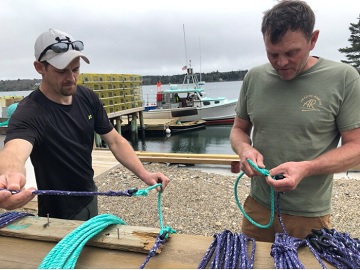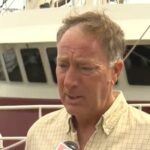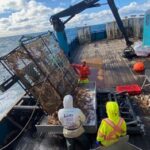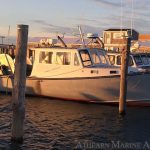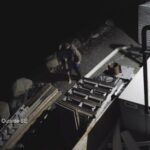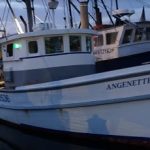Tag Archives: gillnets
Keeping an Industry Afloat – Thomas Goulding’s Cork Mill
 Plastic floats have taken over the market since the 1950s, but before then fishing floats were almost exclusively made of cork or wood. The wooden ones were known as “cedar corks” and the only commercial supplier of them on the West Coast was Thomas Goulding who produced them in his Cork Mill at the Acme Cannery on Sea Island. The Acme Cannery was built in 1899, part of the boom in cannery construction during the late 19th and early 20th centuries to take advantage of the seemingly unlimited supply of salmon available in the Fraser River. In 1902 it was absorbed into the British Columbia Packers amalgamation. In 1918 it closed, but the buildings, net racks and moorage were maintained for the community of fishermen, mostly Japanese, who lived around it. In a small building on the west side of the cannery Mr. Goulding set up the cork mill. The building and all the equipment for the mill, the saws, the lathes, the reamer, the stringer and the tar vat were all hand-built by him with help from his Japanese Neighbours. Photos, maps, more, >>click to read<< 13:38
Plastic floats have taken over the market since the 1950s, but before then fishing floats were almost exclusively made of cork or wood. The wooden ones were known as “cedar corks” and the only commercial supplier of them on the West Coast was Thomas Goulding who produced them in his Cork Mill at the Acme Cannery on Sea Island. The Acme Cannery was built in 1899, part of the boom in cannery construction during the late 19th and early 20th centuries to take advantage of the seemingly unlimited supply of salmon available in the Fraser River. In 1902 it was absorbed into the British Columbia Packers amalgamation. In 1918 it closed, but the buildings, net racks and moorage were maintained for the community of fishermen, mostly Japanese, who lived around it. In a small building on the west side of the cannery Mr. Goulding set up the cork mill. The building and all the equipment for the mill, the saws, the lathes, the reamer, the stringer and the tar vat were all hand-built by him with help from his Japanese Neighbours. Photos, maps, more, >>click to read<< 13:38
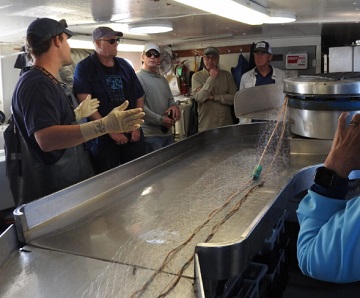
Natural Connections: The Lake Superior Fishery in Wisconsin Waters
The boat engine rumbled and machinery whirred as a gillnet rose from the depths of Lake Superior. Captain Ross Lind managed the throttle so that the 55-foot-long gillnet-tug-turned-research-vessel named Hack Noyes moved toward the net at the same speed the net lifter reeled it in. A group of interested adults on this Museum-sponsored field trip gathered around the equipment. We were mesmerized by the clicking of the metal teeth on the spinning drum as they gripped and then released the line, and by the lengths of delicate nylon net attached to the line. Capable hands guided the net down a long, stainless-steel worktable and into the storage tub. (Check 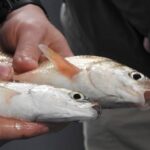 out the Museum’s Reels on Instagram and Facebook if you want to see a video of this operation.) Gillnets look like a long tennis net, anchored by weights along the lake bottom and held vertical by floats. Small fish swim right through, but bigger fish get caught. Whether a DNR biologist or a commercial fisherman is setting the net, they can choose the fish they target by the size of the mesh and the depth of set. >click to read< 19:28
out the Museum’s Reels on Instagram and Facebook if you want to see a video of this operation.) Gillnets look like a long tennis net, anchored by weights along the lake bottom and held vertical by floats. Small fish swim right through, but bigger fish get caught. Whether a DNR biologist or a commercial fisherman is setting the net, they can choose the fish they target by the size of the mesh and the depth of set. >click to read< 19:28
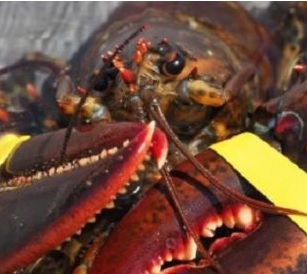
ENGO recommends against consuming lobster over danger to whales
Seafood Watch, a program out of the Monterey Bay Aquarium, says entanglement in fishing gear is the leading cause of death of the critically endangered North Atlantic right whale population, and US and Canadian lobster fisheries aren’t doing enough to prevent it. Jennifer Dianto Kemmerly is vice president of global ocean conservation at the Aquarium. “We really want consumers and businesses to be aware of how dire the situation is,” Kemmerly said. Meanwhile, the international conservation group Oceana blamed the National Marine Fisheries Service for failing to update safeguards that would protect both right whales and lobster fisheries. To remove the red listing, it recommends using ropeless gear, expanding seasonal closures where whales are present, and improving transparency and monitoring of fishing vessels. >click to read< 18:11
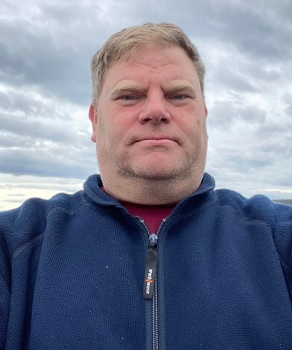
Dismal B.C. herring season sparks renewed calls for moratorium
Three days after setting his nets out in the Strait of Georgia between B.C.’s mainland and Vancouver Island, Josh Young headed back home to Pender Harbour. The herring he was expecting to catch were nowhere to be found. “I will be honest… the stocks I saw this year weren’t the healthiest year I’ve ever seen,” Young said. “We didn’t catch our entire quota.” Young wasn’t alone. When the season opened March 3 for boats equipped with seine nets, they scooped up their fill of the silver foot-long fish in 48 hours. By the time Young and hundreds of others using gillnets arrived on March 5, the fish seemed to have disappeared. “It was a different year,” Young said stoically. >click to read< 16:31
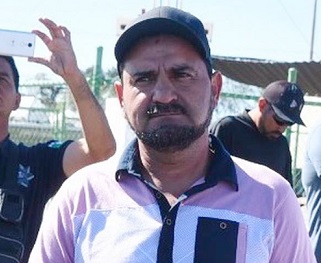
Baja shrimp fishermen defy rules designed to save vaquita
Fishermen are defying rules designed to protect the critically endangered vaquita marina porpoise as the new shrimp season begins in the upper Gulf of California. The federal government this week enlarged by 50% a zero-tolerance zone in the gulf’s northern region where the use of a range of fishing nets including gillnets are prohibited. “We’re just looking for a way to keep working,” García said. He said that fishermen are open to different ways of fishing but asserted that the alternatives currently on the table are not viable. >click to read< 09:41
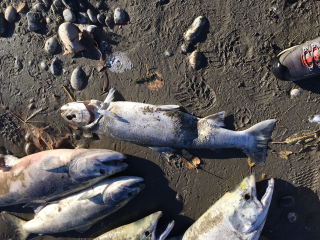
Critics say federal government is wiping out commercial pink salmon fisheries
In emails obtained by the BC Wildlife Federation, British Columbia government staff and scientists say Fisheries and Oceans Canada is burying science and misrepresenting a crisis situation to the public, risking extinction of Thompson-Chilcotin steelhead trout. In the fall of 2017, only an estimated 150 Thompson fish returned alongside just 77 to the Chilcotin down from thousands just a decade and a half ago. The email chain shows the DFO changed the wording of a public scientific document that is based on peer reviewed science. >click to read< 18:40
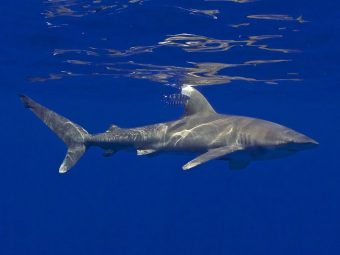
Con Groups File Intent to Sue to Protect Atlantic Sharks, Giant Rays From Lethal Longlines, Gillnets
On behalf of the Center for Biological Diversity and Defenders of Wildlife, Earthjustice today filed a notice of intent to sue the Trump administration for failing to protect oceanic whitetip sharks and giant manta rays from being killed by longlines and huge nets used by U.S. fishermen in Atlantic fisheries. >click to read<13:59
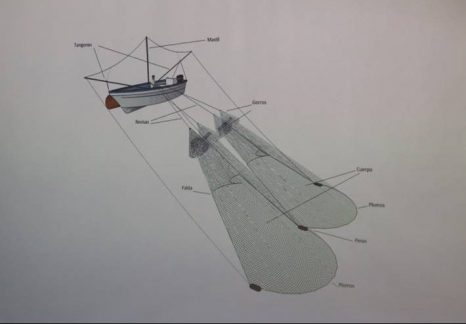
Memorial University flume tank being used for critical conservation work
In the Upper Gulf of California, Mexico, gillnets used in the shrimp fishery have received much of the blame for the plunge in the numbers of a rare marine mammal known as the vaquita.,, One of the key challenges is to encourage Mexican fishermen to change from traditional fishing gear — to get rid of the kilometre-long walls of gillnets in the water that entangle and drown vaquita and other bycatch — and use alternative fishing gear that will be more selective and vaquita-friendly. Such alternative gear is being tested this week in the flume tank of the Centre for Sustainable Aquatic Resources at the Fisheries and Marine Institute of Memorial University in St. John’s. >click here to read< 13:16
Governor Brown’s interference pits her against commercial fisherman
 In an astoundingly ignorant and heavy-handed display of putting urban political correctness ahead of rural jobs, Gov. Kate Brown last week dictated that the citizen members of the Oregon Fish and Wildlife Commission reverse their January decision that gave commercial fishermen a minimally fair share of the Columbia River’s salmon allocation. Addressing commissioners as if they are misbehaving children, Brown told Chairman Michael Finley the commission majority’s acknowledgment of reality is “not acceptable” and that “I expect” the commission to acquiesce to her interpretation of the facts by April 3. Fish and Wildlife Commission members are in an infinitely better position to judge the ineffectiveness of salmon policies than is the governor. Read the Op-ed here 17:03
In an astoundingly ignorant and heavy-handed display of putting urban political correctness ahead of rural jobs, Gov. Kate Brown last week dictated that the citizen members of the Oregon Fish and Wildlife Commission reverse their January decision that gave commercial fishermen a minimally fair share of the Columbia River’s salmon allocation. Addressing commissioners as if they are misbehaving children, Brown told Chairman Michael Finley the commission majority’s acknowledgment of reality is “not acceptable” and that “I expect” the commission to acquiesce to her interpretation of the facts by April 3. Fish and Wildlife Commission members are in an infinitely better position to judge the ineffectiveness of salmon policies than is the governor. Read the Op-ed here 17:03






